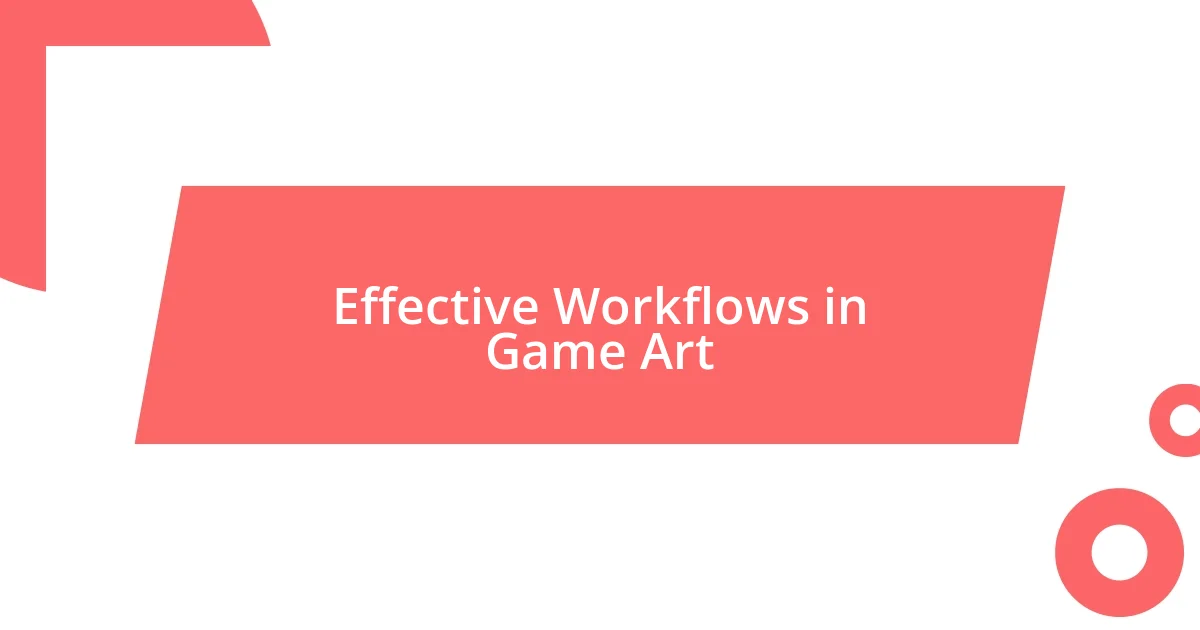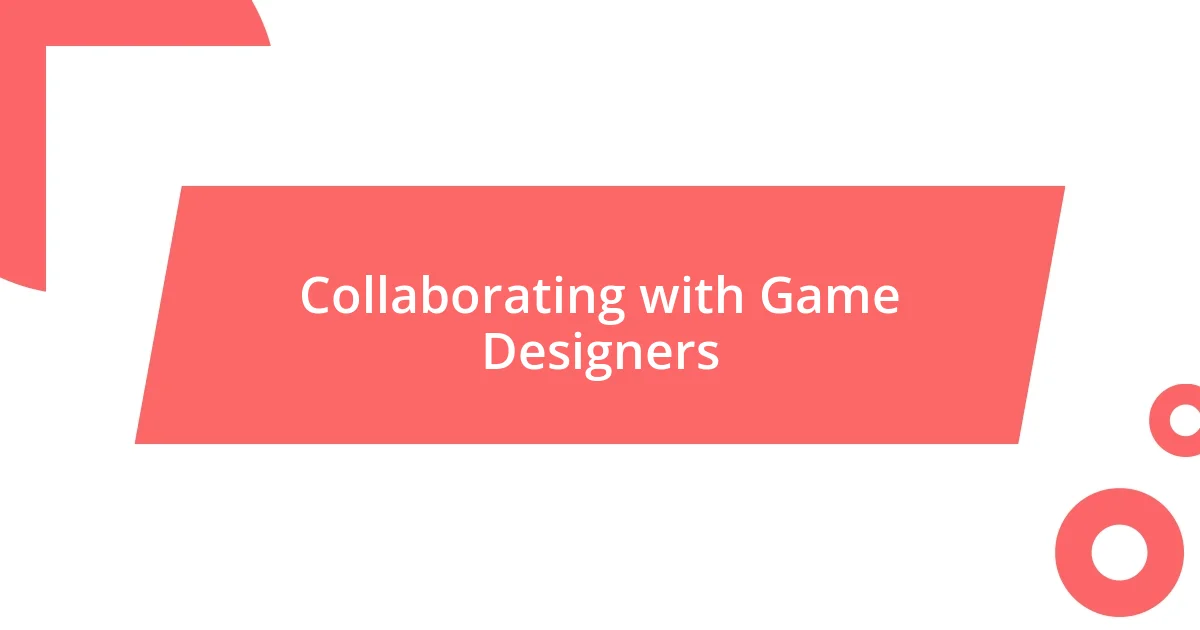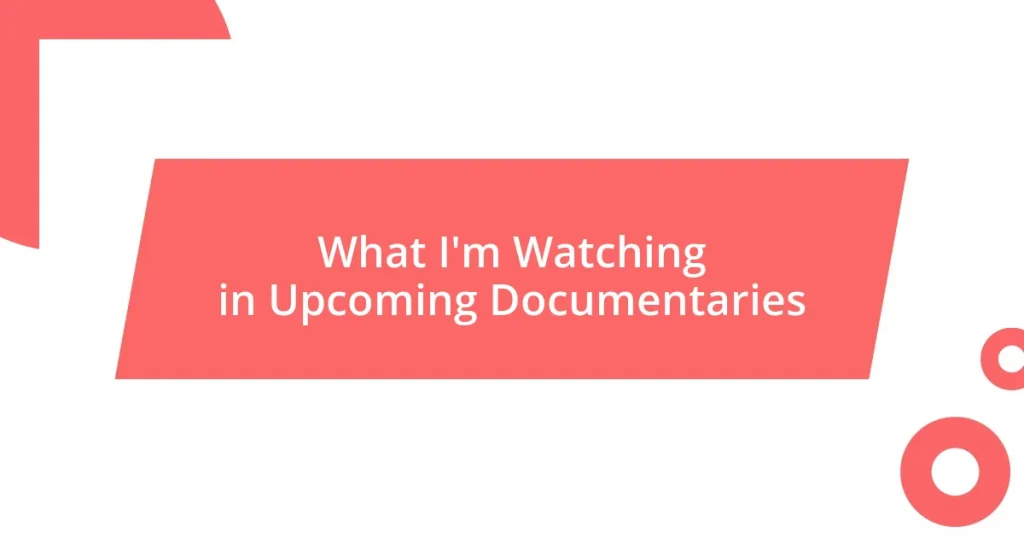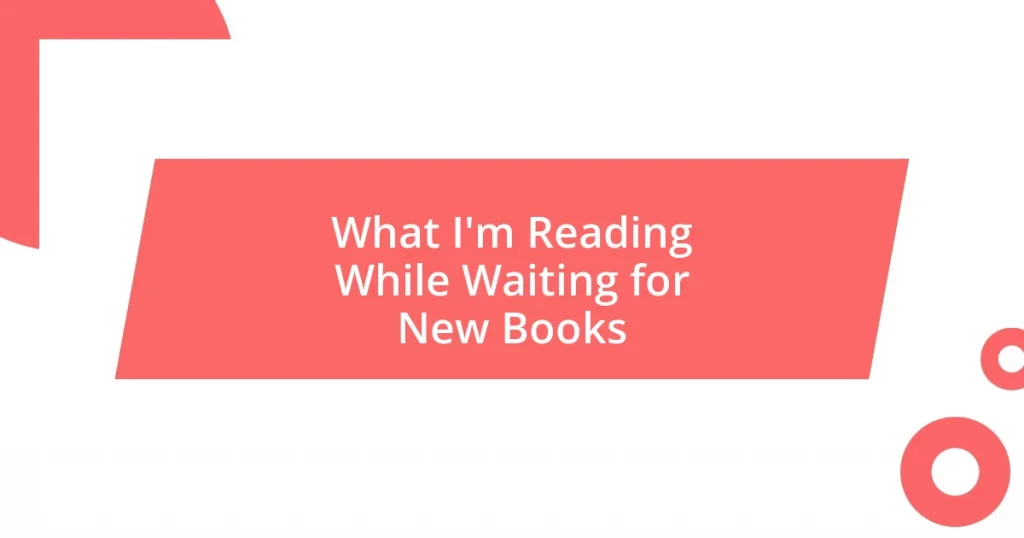Key takeaways:
- Understanding game art fundamentals such as color theory, dynamic lighting, and texture mapping enhances the overall immersive experience of a game.
- Collaboration with game designers is crucial for creating art that supports gameplay mechanics and enhances player engagement.
- Showcasing a tailored portfolio effectively attracts potential collaborators and employers, emphasizing the importance of audience-specific presentation strategies.

Understanding Game Art Fundamentals
Game art fundamentals are like the backbone of any game development process. When I first started in the world of digital art, I realized how crucial understanding color theory and composition is. Have you ever noticed how a well-composed scene can pull you in? It’s fascinating how a simple color palette can set the mood and tone of the entire game.
One of my early projects involved creating backgrounds for a side-scrolling adventure game. I vividly remember experimenting with different lighting techniques to create depth. The depth wasn’t just aesthetic; it stirred emotions, almost as if the scenery was telling its own story. It made me question: how do small shifts in design impact the player’s experience?
Texture mapping is another indispensable element that I can’t overlook. Initially, I struggled with it, feeling overwhelmed by the myriad of techniques. But over time, I learned that textures can breathe life into 3D models. I still recall the joy of finally nailing a realistic rock texture, which made the environment feel genuinely immersive. Isn’t it incredible how ground-level details can elevate an entire gaming experience?

Techniques for Creating Game Art
One technique I find invaluable in creating game art is the use of dynamic lighting. I remember a late-night session where I was fine-tuning the lighting for an eerie forest scene. It struck me how changing just a few light sources completely transformed the atmosphere—from inviting to spine-chilling. The shadows danced off the trees, creating an immersive experience that pulled players into the narrative.
Here are some techniques I consider essential for enhancing game art:
– Dynamic Lighting: Adjust light sources to evoke emotions and set the game’s tone.
– Texture Mapping: Invest time in detailed textures to add realism and depth.
– Color Grading: Use color adjustments in post-processing to unify the game’s visual style and influence mood.
– Layering and Composition: Build layers to add depth, ensuring elements don’t compete but complement each other.
– 3D Modeling Software Proficiency: Familiarize yourself with tools like Blender or Maya for creating more refined assets.
Each of these techniques contributes significantly to the experience, making the game world feel alive and engaging—just as I experienced when the right lighting transformed my scenes.

Tools for Game Art Development
When it comes to tools for game art development, I can’t stress enough the importance of selecting the right software. I remember the first time I used Photoshop for digital painting; it felt like unlocking a treasure chest of creative possibilities. The multitude of brushes allowed me to fine-tune every detail, from character designs to stunning backgrounds. For 3D modeling, programs like Blender have truly revolutionized my workflow. I still recall the excitement of my first animation, bringing a character to life—it’s a feeling I can hardly put into words.
There’s also a noteworthy comparison between software options. Some tools are geared towards specific styles or features, which can significantly influence your workflow. For instance, while ZBrush excels in high-resolution sculpting, Photoshop is my go-to for texture creation. Each tool has its unique strength, and understanding these differences can greatly impact your project’s direction.
Here’s a quick comparison of popular tools that I frequently use:
| Tool | Primary Function |
|---|---|
| Photoshop | 2D art and texture creation |
| Blender | 3D modeling and animation |
| Unity | Game development engine |
| ZBrush | High-resolution sculpting |
| Maya | Animation and rigging |
Choosing the right tool can feel overwhelming at times, but I’ve learned that it’s about finding what resonates with you personally. I often ask myself what kind of project I envision, and that guides my decisions. Over the years, this approach has helped me to be more efficient and inspired in my creations. What tools do you find indispensable in your game art journey? I’m always eager to learn from others’ experiences.

Developing a Unique Art Style
Developing a unique art style is a journey filled with experimentation and self-discovery. I still vividly remember the day I decided to mix surrealism with classic fantasy elements. It was an exhilarating challenge that pushed me to think outside the box. How could I blend dreamlike scenes with a medieval aesthetic? This exploration not only shaped my visual identity but also resulted in artwork that resonated deeply with players.
I believe that every artist brings their own unique experiences into their work. I often find inspiration from the world around me, whether it’s a color palette I see in nature or the emotional weight of a song. One evening, while wandering through an art gallery, a particular abstract piece struck a chord with me. It made me realize how powerful shapes and colors can tell a story. This revelation has been a driving force in my art style—allowing me to showcase my emotions through abstract forms while still maintaining recognizable elements. How do you translate your personal experiences into your art?
Finding your unique style takes time and patience, and it’s often beneficial to embrace the process. For instance, I experimented with various mediums before landing on the digital format, which felt more organic to me. I remember the first time I used a stylus on a tablet—it opened a door to a new level of creativity I hadn’t anticipated. Each failure along the way taught me valuable lessons, helping to refine my voice as an artist. So, what experiments have you tried that shaped your artistic journey? Embracing exploration can ultimately lead to the signature style that sets you apart.

Effective Workflows in Game Art
Effective workflows in game art are essential for enhancing creativity and productivity. I vividly recall the satisfaction of creating a scheduling system for my projects; it was like giving my chaotic brainstorming a structured home. I usually break down tasks into manageable chunks, which keeps my focus sharp and prevents overwhelm. Have you ever tried segmenting your work this way? It can transform a daunting project into a series of achievable goals.
Collaboration is another key aspect that has greatly influenced my workflow. I remember a project where I teamed up with a talented musician; their feedback on my art inspired a deeper connection between visuals and sound. Regularly sharing progress not only fosters creativity but also opens doors for new ideas. How do you engage with your peers during your creative processes? For me, feedback is like the spark that ignites my next creative step.
Finally, don’t underestimate the power of routines. Early on in my game art journey, I set aside specific times for sketching, modeling, and reviewing work. This consistency has become my creative anchor, guiding me through busy days. When I stick to my schedule, I find that my creativity flows more freely, allowing me to explore ideas without interruption. What routines do you find effective in your work? Establishing a rhythm can make a world of difference in your artistic journey.

Collaborating with Game Designers
Collaborating with game designers is a rewarding experience that adds layers to my creative process. I remember a particular instance when I was working on a multiplayer game. The game designer had a clear vision of the gameplay mechanics, but it was through our discussions that I discovered how to visually interpret those mechanics into engaging art. Their perspective helped me realize the importance of ensuring that every piece of artwork not only looks good but also serves a functional purpose in gameplay. Have you ever noticed how art can enhance player immersion? That synergy between art and design is what makes a game truly compelling.
Communication is vital in these collaborations. I often find myself sketching ideas on the fly during brainstorming sessions. One time, I drew a character while discussing its personality traits with a designer. As we spoke, I could feel the energy in the room shift; we were building the character together, layer by layer. This back-and-forth exchange not only strengthens the design but also creates a sense of collective ownership over the project. How do you express your creative thoughts to your collaborators? I believe that actively listening to their insights is just as important as sharing your own.
Another aspect I cherish in these collaborations is the blend of artistic styles and ideas. Recently, one designer influenced me to explore a color palette I wouldn’t typically use. It felt uncomfortable at first, but stepping outside my comfort zone resulted in some of the most vibrant artwork I’ve ever created. Our discussions led to experimenting with different styles that reflected the game’s emotional tone. Have you experienced a similar shift in your work through collaboration? Such exchanges not only foster creativity but also pave the way for artistic growth.

Showcasing Your Game Art Portfolio
Showcasing your game art portfolio is a critical step in making an impression on potential collaborators and employers. I remember the first time I presented my portfolio – it felt like unveiling a part of my creative identity. I carefully curated pieces that not only demonstrated my technical skills but also conveyed my artistic vision. Have you ever felt that thrill of sharing your work? It’s incredible how a well-chosen selection can spark conversations and connections.
One strategy I’ve found effective is to tailor my portfolio to the audience. When presenting to a game studio, I emphasize pieces that align with their projects’ aesthetics and themes. An experience that stands out was when I adjusted my portfolio for a studio focused on retro-style games, incorporating pixel art that I originally created just for fun. This little alteration drew their attention and led to a productive dialogue about my approach to game design. What’s your strategy for showcasing your work? Adapting to the needs of your audience can truly elevate your chances of grabbing their interest.
Additionally, the presentation method matters. I often choose between digital formats or a physical portfolio based on the context. There’s something special about holding a beautifully printed booklet, but I’ve had great success with interactive digital portfolios that allow for quick navigation. One memorable moment was during a virtual meeting, where I shared my digital portfolio; seeing their faces light up with every click was both satisfying and motivating. Have you considered how the medium can influence viewer interactions? No matter the choice, the key lies in making the experience engaging and memorable for your audience.















